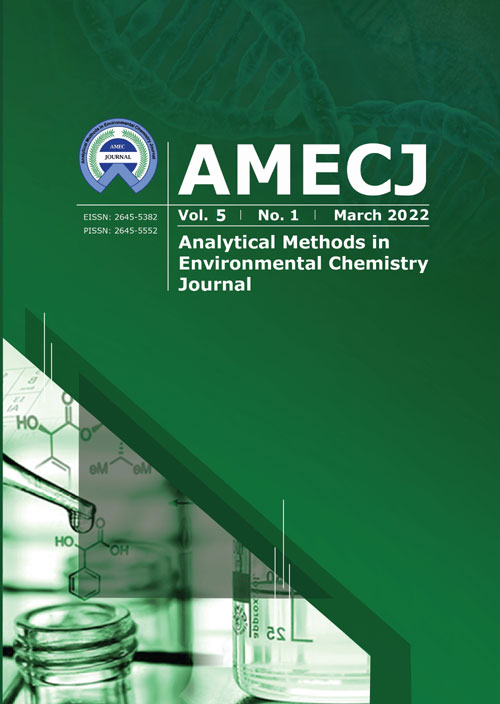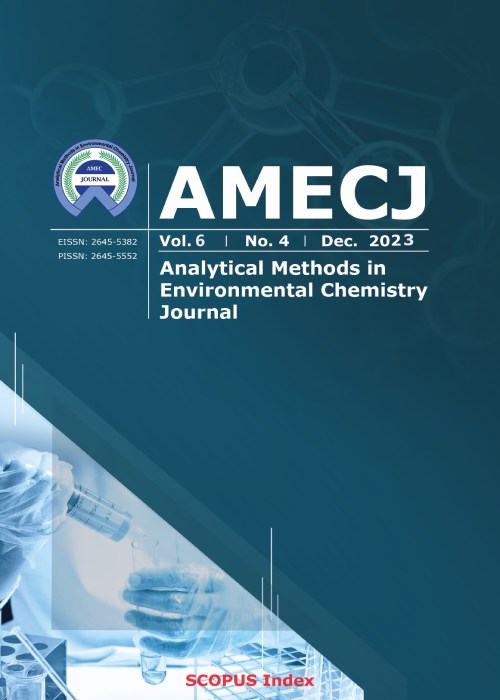فهرست مطالب

Analytical Methods in Environmental Chemistry Journal
Volume:5 Issue: 1, Mar 2022
- تاریخ انتشار: 1401/01/27
- تعداد عناوین: 7
-
Pages 5-21
Determination of environmental pollution in the surface water is very important. So, in this study, determination, and health risk assessment were evaluated. The pollutions such as anions, cations, and heavy metals were analyzed in surface water by photometer spectrometry and atomic absorption spectrometry (AAS). Other parameters such as pH and TDS were determined. The results showed us, the electrical conductivity (EC) in this study falls between 100.68 ± 1.0 - 194.74 ±1.4 μs cm-1 in the dry and wet season. The pH value in this study for the two seasons varied from 5.57±0.22 to 5.73±0.28 which shows a little acidity. In the current study, TDS for wet and dry seasons goes from 122.17±1.74 mg L-1 to 63.80±0.86 mg L-1. This may conceivably be a sign of typical pollution from the runoff of soils in the study area. The high phosphate levels in both wet and dry seasons are recorded from 60.74±0.61 to 60.27±0.38 mg L-1 in both seasons. Iron values observed range from 8.42±0.06 to 6.28±0.11 mg L-1 in the wet and dry season, Cu was recorded between 0.08±0.01 - 0.07±0.01 mg L-1, Mn recorded from 0.07±0.01 to 0.06±0.01 mg L-1, Zn recorded between 2.29±0.09 - 1.15±0.09 mg L-1, and Pb recorded from 0.69±0.09 to 0.40±0.18 mg L-1 while Cd and Ni were not detected in the study. Water quality index (WQI) values were determined as 549 for wet and 328 for the dry season, the hazard indices for both seasons are below one. The outcomes in this present study showed that the level of Pb in the surface water could present a carcinogenic risk to both adults and children. All heavy metals results were validated by electrothermal atomic absorption spectrometry (ET-AAS).
Keywords: Heavy metal, Environment, Pollution, Surface water, Spectrophotometer, Atomic absorption spectrometry -
Pages 22-35
Heavy metals are a major cause of environmental pollution, and mercury is a well-known toxicant that is extremely harmful to the environment and human health. In this study, new carbon nanotubes coated with cobalt and molybdenum nanoparticles (Co-Mo/MWCNT) were used for Hg0 removal from the air by the amalgamation of solid-phase air removal method (ASPAR). In the bench-scale setup, the mercury vapor in air composition was produced by the mercury vapor generation system (HgGS) and restored in a polyethylene airbag (5 Li). In optimized conditions, the mercury vapor in the airbag passed through Co-Mo/MWCNT and was absorbed on it. Then, the mercury was completely desorbed from Co-Mo/MWCNT by increasing temperature up to 220 °C and online determined by cold vapor atomic absorption spectrometry (CV-AAS). The recovery and capacity of Co-Mo/MWCNT were obtained at 98% and 191.3 mg g-1, respectively. The Repeatability of the method was 32 times. The mercury vapors absorbed on Co-Mo/MWCNT adsorbent could be maintained at 7 days at the refrigerator temperature. The Co-Mo/MWCNT as a sorbent has many advantages such as; high capacity, renewable, good repeatability and chemical adsorption (amalgamation) of mercury removal from the air. The method was successfully validated by a mercury preconcentrator analyzer (MCA) and spiking of real samples.
Keywords: Mercury removal, Air, Adsorption, Cobalt, molybdenum nanoparticles, Multiwalled Carbon nanotube, Amalgamation solid-phase air removal -
Pages 36-48
Nitrate is a hazardous substance for human health, the removal of which is an important environmental priority. Therefore, in this study, first, the sources of nitrate pollution of water were investigated, then the structure, role, and application of nanozeolites for the removal of nitrate ions were studied by the analytical method. Also, the presentation of management solutions, identification of polluting industrial sectors, different methods of removal and fabrication of ZSM-5/Fe/Ni nanosorbents, and the determination of optimal conditions for nitrate removal were investigated by experimental design software and graphical analysis of effective parameters. The results of graphical analysis of laboratory method showed us, the highest nitrate removal efficiency at a residence time of 150 minutes, pH 3, 4 g L-1 adsorbent, and 40 mg L-1 nitrate were achieved (%RE:91.5-97.4). Experimental results indicate the high efficiency, absorption capacity, and effectiveness of ZSM-5/Fe/Ni adsorbents for nitrate removal in waters. Finally, the absorbance values or nitrate concentrations between 20-120 mg L-1 were measured by the UV-Vis spectrophotometry. The maximum absorption capacity of ZSM-5/Fe/Ni adsorbents for nitrate was obtained 136.7 mg g-1. The developed method based on a novel ZSM-5/Fe/Ni adsorbents has many advantages such as simple, low cost, high efficiency, and favorite recovery of more than 90% for removal nitrate in water samples by nanotechnologies as compared to other reported methods.
Keywords: Removal, Nitrate, Adsorption, Water samples, Nanozeolite, UV-Vis spectrophotometry -
Pages 49-60
Heavy metals (HMs) are considered as the major environmental pollutants that accumulated in soil and plant. Consumption of such contaminated plants by humans and animals would ultimately harm the health of communities. This study aims to evaluate the amount of copper(Co), cadmium(Cd), and lead(Pb) in soil and cultivated plants that are irrigated by the city of Zabol’s wastewater. Also, the heavy metals determined in 20 mL of Zabol’s water based on Bis(triethoxysilylpropyl)tetrasulfide (S4[C3H6Si(OEt)3]2, TEOSiP-TS) modified on MWCNTs as an adsorbent by the uniform dispersive -micro-solid phase extraction (UD-μ-SPE) at optimized pH. In this study, 52 samples including wheat, corn grain, and wild spinach, as well as agricultural soil were selected randomly from three village stations. The concentrations of heavy metals in plants, soils, and water samples were measured using a flame atomic absorption spectrometer (F-AAS). The one-way ANOVA test was applied to compare the mean value of heavy metals at the three mentioned stations. The results indicate that the amount of lead at all three stations and in all types of plants exceeds the permissible range. The amount of copper in plant species and water is lower than the permitted range, while it is higher in agricultural soil. By optimizing parameters, the linear range (LR) and the detection limit (LOD) of Cu, Cd, and Pb were obtained 1.5-1000 μg L-1, 1-200 μg L-1, 5-1500 μg L-1 and 0.5 μg L-1, 0.25 μg L-1, 1.5 μg L-1, respectively in water samples (RSD%<2). This study indicates that irrigation of agricultural fields using wastewater causes the accumulation of heavy metals in soil and plants.
Keywords: Heavy Metals, Environment sample, Bis(triethoxysilylpropyl)tetrasulfide, Uniform dispersive -micro-solid phase extraction, Flame atomic absorption spectrophotometer -
Pages 61-74
Acetaminophen is a widely used drug worldwide and is frequently detected in water and wastewater as a high-priority trace pollutant. This study investigated the applicability of the adsorption processes using a composite of magnetic chitosan and multi-walled carbon nanotubes (MCS@MWCNTs) as an adsorbent in the treatment of acetaminophen. The model was well fitted to the actual data, and the correlation coefficients of R2 were 0.9270 and 0.8885, respectively. The maximum ACT removal efficiency of 98.1% was achieved at ACT concentration of 45 mg L-1, pH of 6.5, MCS@MWCNTs dosage of 400 mg L-1, and the reaction time of 23 min. The result shows that BET specific surface area of 640 m2 g-1. The adsorption isotherms were well fitted with the Langmuir Model (R2 =0.9961), depicting the formation of monolayer adsorbate onto the surface of MCS@MWCNTs. The maximum monolayer adsorption capacity of 256.4 mg g-1 was observed for MCS@MWCNTs. The pseudo-second-order kinetic model well depicted the kinetics of ACT adsorption on MCS@MWCNTs (R2=0.9972). Desorption studies showed that the desorption process is favored at high pH under Alkaline conditions. The results demonstrate that the MCS@MWCNTs is an efficient, durable, and sustainable adsorbent in water purification treatment.
Keywords: Adsorption, Acetaminophen, Experimental design, Isotherm, Kinetic, Regeneration -
Pages 75-85
Exposure to hexavalent chromium (Cr VI) causes cancer in cells of the human body. So, the speciation and determination of the Cr (VI) and Cr (III) in water and human samples based on sensitive techniques are necessary. In this research, 2-mercapto-1-methylimidazole a novel Task-specific ionic liquid (C4H6N2S; HS-CH3-IM) was used with a new approach for speciation of Cr (III, VI) from water samples by ultra-assisted dispersive ionic liquid-liquid microextraction procedure (USA-D-ILLME). Due to the procedure, 100 mg of HS-CH3-IM and 0.2 mL of acetone were mixed and injected into 10 mL of water or standard Cr (III) and Cr (VI) solution in the conical tube. After stirringfor 5 min, the Cr (VI) and Cr (III) were extracted with a positive and negative charge of the thiol group (HS2+, HS-) in pH 2 or 8 and pH 5, respectively. The mixture of the HS-CH3-IM was collected at the bottom of the conical tube by centrifuging. The upper liquid phase was vacuumed with a peristaltic pump and the Cr (III, VI) loaded on the HS-CH3-IM was back-extracted in a liquid solution. Finally, the concentration of the Cr (III, VI) ions in a remained solution were measured with ET-AAS after dilution up to 0.5 mL with DW. The total chromium was determined in water samples by summarizing the Cr (VI) and Cr (III) contents. All parameters such as the amount of HS-CH3-IM, the sample volume, pH, and the shaking/centrifuging time were optimized. Under the optimal conditions, good linear range (LR), LOD, and enrichment factor (EF) were obtained 0.05–1.7 μg L−1, 15 ng L−1, and 19.82 respectively (RSD% < 1.45). The procedure was validated by spiking samples and good accuracy and precision results were achieved.
Keywords: Chromium III, VI, Water samples, 2-Mercapto-1-methylimidazole, Dispersive ionic liquid-liquid microextraction, Electrothermal atomic absorption spectrometry -
Pages 86-96
A voltammetry method for the determination of pyrogallol (PY) was developed employing a carbon paste electrode (CPE) modified with CdS nanoparticle that was synthesized by microwave.The effect of different parameters i.e. time and irradiation power on the morphology and the sample’s particle size have been investigated. The synthesized nanostructures were characterized by X-ray diffraction and scanning electron microscopy. Theoptimized condition for time and power consumption to prepare CdS nanoparticles was obtained 4 min and 360 W. Cyclic voltammetry study of the modified electrode indicated that the oxidation potential shifted towards a lower potential by approximately 106 mV and the peak current was enhanced by 2 fold in comparison to the bare CPE. The effect of pH and interferences from some inorganic salts and organic compounds were studied. The usability of this method for the quantification of pyrogallol was investigated with differential pulse voltammetry (DPV). Under the optimal conditions, the peak current was proportional to pyrogallol concentration in the range of 7.0 ×10-7 to 3.0 × 10-4 mol L-1 with a detection limit of 4.8 × 10-7 mol L-1. These values are satisfactory for application to real samples. Finally, the developed method was successfully used for the analysis of real samples.
Keywords: Pyrogallol, Analysis, Carbon paste electrode, Differential pulse voltammetry (DPV), Cyclic voltammetry(CV), CdS nanoparticles


